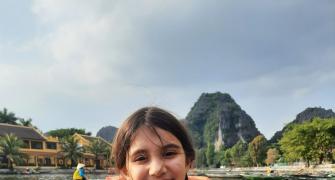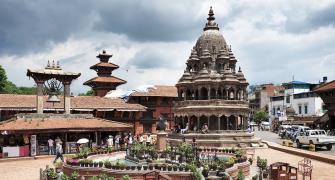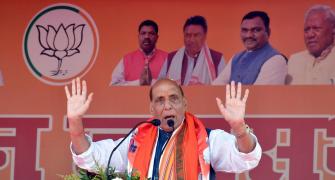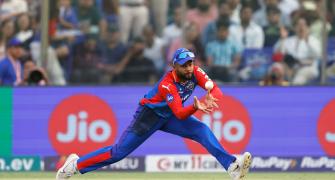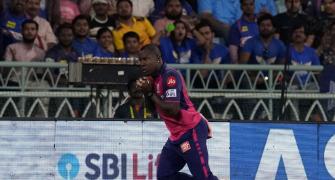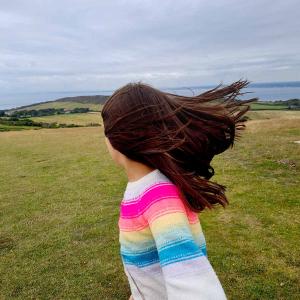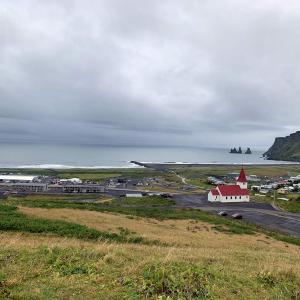Brahma, Vishnu, Shiva, Ram, Laxmi, stories from the Hindu epics are seen in carvings, paintings and murals, as well as recognisable figures from mythology, like Garuda, Sheshnag, Nandi and Apsaras, notes Deepa Gahlot, savouring the beauty of Cambodia.

Cambodia wakes up early. Most tourist-magnet monuments open at 7 am. And even earlier, young people can be seen on the streets, bicycling or mo-biking their way to work.
To beat the heat perhaps, or just to catch up with the neighbouring countries in the Far East -- Thailand, Korea, even Vietnam are prospering, while tiny Cambodia is still recovering from brutal colonialism, destructive occupations and the horrific genocide during the Pol Pot regime that wiped out a quarter of the country's population.
Which is also why Cambodia is a young country -- there are hardly any old people visible.
Every family lost its loved ones, and the targets were writers, artists, journalists, teachers, people with soft hands, who were then sent out to do hard labour, starved, beaten and tortured to death.
Landmines left in the fields, killed or blew up limbs of people, and many of them are seen at tourist spots playing music or selling books or souvenirs.

But the horrors of the Khmer Rouge could not wipe out the beauty of the country, the serenity of its people and the centuries of a Hindu-Buddhist syncretic culture that created the stunningly magnificent Angkor Wat temples, in the Siem Reap province, the largest complex of religious structures in the world -- a major tourist attraction and a UNESCO World Heritage Site.
Also the reason why Angelina Jolie is such an icon in the country -- Lara Croft: Tomb Raider (2001) was shot at the Ta Phrom temple in Siem Reap and got Western tourists interested in Cambodia.
She went on to adopt a Cambodian child, direct a film, First They Killed My Father (2018) about the Khmer Rouge cruelty, which won her a Golden Globe nomination; she supports projects to clear undetected land mines, works in wildlife and environment conservation, has set up employment schemes to help locals.
For her humanitarian work in the country, she was granted Cambodian citizenship by King Norodom Sihamoni (son of Norodom Sihanouk, a more familiar name internationally)

The week-long Angkor And More Cambodia trip, curated by Bharat Gothoskar, founder and CEO of Mumbai-based Khaki Tours, gives the traveller an insight into the history and heritage of the country -- to study the culture deeply would obviously require many more days or visits.
The journey starts at the centre of the capital city Phnom Penh -- meaning Penh's Hill -- named after a wealthy woman named Penh, as the legend goes, who in 1372, saw a tree floating down the Tonle Sap river and inside the trunk were four bronze Buddha statues and one stone statue of Vishnu.
She built a temple to house the idols. The originals must have disappeared or been destroyed, but there is the Wat Phnom Daun Penh temple that has some beautiful Buddha statues, which people come to worship with incense, money and lotus flowers.
Buddhism permeates the very soul of the country, with most homes having small shrines at the entrance.
Phnom Penh, situated by the Mekong (the Khmer version of Ma Ganga), Tonle Sap and Bassac rivers, became the permanent capital of Cambodia in 1866 after every ruler had shifted capitals according to circumstance or whim.
It was developed into a modern city by the French colonialists, and today shows all the traits of a busy metropolis, studded with a mix of French and Khmer architecture with the distinctive sloping roofs and the elephant, dragon, Garuda or Buddha motifs prominent all over.
The main streets are clean, the traffic glides quietly, with no honking, and the people are friendly, even with the language barrier hindering communication.

The Royal Palace of Cambodia is a large cluster of elegant buildings, collections of pavilions, pagodas, rooms full of artefacts and large gardens dotted with statues.
The king's residential area is obviously out of bounds, but there is plenty for tourists to see and admire. The mural telling the story of the Ramayan is fading, but has still much to marvel at.
Phnom Penh by evening is lit up and bustling with people out for a stroll. The riverside promenade with its peddlers, fortune tellers and food stalls (fried insects are sold as a snack), would remind a Mumbai traveller of the Marine Drive or Colaba promenade.
A river cruise gives a glimpse of the city with its twinkling lights.

The National Museum gives just a hint of Angkorian artefacts, but the actual awe-inspiring location is still to be visited.
The Hindu influence is visible all over -- Brahma, Vishnu, Shiva, Ram, Laxmi, stories from the Hindu epics are seen in carvings, paintings and murals, as well as recognisable figures from mythology, like Garuda, Sheshnag, Nandi and Apsaras.

In a peaceful part of the city, surrounded by normal residential dwellings, is a non-descript school building, the classrooms of which had been converted into torture chambers by the Khmer Rouge soldiers. The rooms, the clothes of victims -- including children -- the photographs of the killed have been preserved for the world to see how the country suffered at the hands of its own people.
Only seven of the thousands killed in the torture rooms survived, and two of them sit in the complex, signing books or posing for pictures with visitors.

If this place with its ghoulish air is distressing, a visit to one of the many killing fields can cause nightmares. The Oscar-winning Hollywood film, The Killing Fields (1984), revealed the atrocities of the Pol Pot regime, but seeing the place where people were beheaded (the skulls have been displayed) and bodies thrown into mass graves is more devastating.

A visit to a floating village of Kompong Luong -- where people, mostly of Vietnamese origin, stay in boats and make a living fishing -- is an antidote to the shock of the Pol Pot massacres.
IMAGE: Getting a closer look of the floating village. Video: Deepa Gahlot
Since this trip concentrates on history, the usual touristy beaches are skipped for a visit to the town of Battambang, where examples of French architecture as well as a rare Cambodian home built of wood can be seen.

When Vietnam attacked Cambodia after the Civil War, the soldiers dismantled the carved wooden houses and carried away the timber.
A ride on the Bamboo Train takes the traveller into the tranquil countryside. These 'Norries' or open bamboo platforms, propelled by motor engines were once a mode of transport of goods and people through the villages.

The high point of the trip are the magnificent temples of Angkor Wat -- now many in ruins, but still showing off the aesthetic and architectural splendour of the structures. Cambodia's national flag has Angkor Wat on it, which underlines its significance.
Seeing all the 1,000 plus temples would take many weeks, but Bayon, Banteay Srei, Ta Prohm, Preah Khan, Neak Pean temples are a sight to behold. Indians recognise the idols and the stories carved on the lintels, but even for the untrained eye, the art and craftsmanship are overwhelming.

Indians had travelled to the Far East to trade and the legend goes that a local princess had married a Hindu and that's how the religion took root in the country.
The construction of the Angkor remples took place over 28 years from 1122 to 1150 CE during the reign of King Suryavarman II. In 1177, Angkor was destroyed by the enemy Chams, and restored by the new king, Jayavarman VII, who had converted to Buddhism under the influence of his wife Indradevi.
So, many temples had idols of Buddha; later there was a Hindu resurgence, and the image of Buddha was erased from the carvings. The large headless Buddha statues could also be the result of vandalism, theft and smuggling of antiques.
Here and there are signs indicating restoration work in which India as well as countries from the European Union are involved. The Angkor National Museum is then a mandatory stopover for those whose curiosity has been whetted by the temples, to gain a historical overview of the country.
In the past, the Khmer empire had spread far beyond the borders of Cambodia, but after those days of glory, followed by wars with neighbouring countries, French colonialism, occupation by Japan and Vietnam, bombings by the US and the dark Khmer Rouge days, the country today is still struggling to get back on its feet.
Tourism is a large source of employment and income. There are stone handicrafts, lacquer work and silk ikat made by local artisans, but hardly anything is manufactured in Cambodia and there is dependence on aid from the West.
The country has had its historical and political upheavals and tremendous suffering, but there is very little bitterness or anger on view. "Buddhism saved us," says the local guide, Kim Thet, "we learnt to forgive, otherwise, the fighting would never end. We have to look at the future, not the past."


Feature Presentation: Ashish Narsale/Rediff.com

